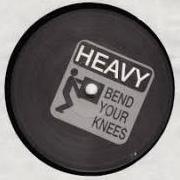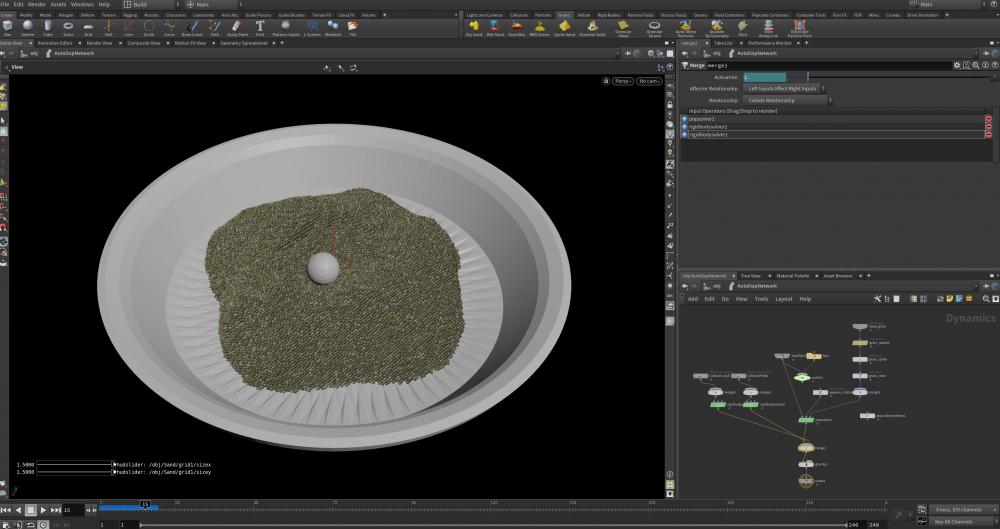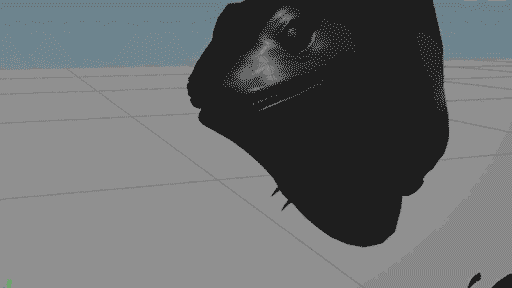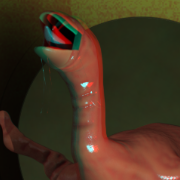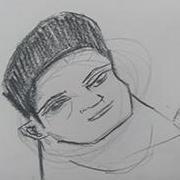Search the Community
Showing results for tags 'Collisions'.
-
How please, is the best way to go about colliding 3 liquids? What is important is that each can be rendered differently. Thanks in advance, 5D
-
- flip
- collisions
-
(and 1 more)
Tagged with:
-
Hi everyone. My first post. I`m sorry. I cant post Hip file. (NDA reasons) I have scene, where I need to copy to points exact amount of pigs (varies between 8-20 - weighted distribution) Everything is ok, but now I need to rid off self penetrations. Is there an elegant solution to this problem? (Maybe VEX magic - loop through objects, then move a bit) I tried following methods so far: 1. Set pscale by Volum Spheres: It`s legit method, but it works best in 3D. I think it`s little bit overkill. 2. Houdini Simon`s method of subtraction. Its slow (I`ve found HDA which does the same, but in VEX - link: https://mcworldkit.gumroad.com/l/CollisionsRemoval) I don't have full control how many pigs will be removed though. Thank you for all your help
- 8 replies
-
- scatter
- collisions
-
(and 1 more)
Tagged with:
-
Dear Houdiniers, I am doing a heavy FX shot, mostly FLIP colliding with geometry and whitewater from that FLIP. I need to cache multiple .sim and .bgeo.sc sequences for various different SOP and DOP nets. It WAS..... all working fine, but now caching anything it seems, whether "save to disk" or "save to disk in background", doesn't work properly. In save to disk it seems to hang and when in background randomly decides to finish early and jump to 100%. There seems to be no pattern to the amount of $SF it gets to, at least none I can discern. I have tried down rezing it and allowing caching to disk to no sucess. I hope someone can help. This is a shot that may land me my first job in the industry, fingers crossed! Cheers 5D PS: haven't included .hip because it has so much cache all over the place. Should I upload it anyway??
-
hello, i am beginner to houdini i want to animate one object to hit with the ground without simualtion , how that would be possible ! thanks
-
Hey guys, I'm not sure why this is happening. But when I rotate an object that is fed into the vellum collision geo stream, my vellum sim geo always falls through it. I've increased the collision iterations to a very high number along with substeps, and still no luck. I've also adjusted the thickness of the constraints. Any advice as to how to avoid this? Thanks
-
Hey guys, I'm not sure why this is happening. But when I rotate an object that is fed into the vellum collision geo stream, my vellum sim geo always falls through it. I've increased the collision iterations to a very high number along with substeps, and still no luck. I've also adjusted the thickness of the constraints. Any advice as to how to avoid this? Thanks
-
Hi team! I have followed a good tutorial on Youtube as I was having issues with keeping fluid in a container, this tutorial also shows how to do bubbles in the water ( Tutorial here ) When the bubbles go through the water there is a loss of fluid and I have been playing around a lot trying to figure out how to prevent the loss, when the collision objects aren't connected there is no loss in the amount of fluid but when I connect the Collison object there is a loss of fluid and I cant figure out how to stop that. I was wondering if anyone else happened to know? Its just bothering me and I wanted to know the answer. Cheers! Hottub.hipnc
- 2 replies
-
- collisions
- collision
- (and 6 more)
-
Hey, I'm currently trying to get my skeleton object to interact with my vellum grains sim, I want it to start from sleeping and get awakened by the character animation pushing through it to imitate snow. Any help would be appreciated! If you could explain more, how/why this makes sense to Houdini will be even better to build my understanding for the program as I'm still a noob Snow_Crawl_2.hip
-
Greetings, I'm trying to achieve something like this https://www.shutterstock.com/video/clip-24306053-slow-motion-falling-eggs-into-flour-stock Forget about the eggs, generally I'd like to simulate a collision on a dust / powder like flour. First of all, how should I approach this effect? Particles or Grains? And if I choose Grains, should I use the normal Grain Solver or the Vellum one? On the picture below I have a setup that I used the standard Grain Solver, and 2 RBD object, on is the static plate, and the other one is the moving ball. I encounter many problems like the ball bouncing really hard on the flour, instead of just landing, and if I change the RBD Solver priority in the Merge, then the Grain collide merely good with the ball but they pass through the plate. So basically the Solver can't read both the RBD objects correctly. Also, after all, I need to use a custom Force to "Explode" some Grains in the air, because it seems impossible to happen with just the ball collision. Thank you in Advance !!
-
Greetings, I'm working on a simulation, kinda a classic one, with Viscous Chocolate been poured on Yogurt. Basically a Viscous Liquid Collides with a more Viscous Liquid. I did the Chocolate pouring and it looks really nice at first, now I need to replace the Ground plane with the Viscous Yogurt. I had the idea of using Narrow Band for the Yogurt surface and using double viscosity than the chocolate. But in my bad luck you can't Merge 2 Flip Solvers. I've read that you can use 2 Flip Objects though, but how do I import the Narrow Band in one Flip object and the other Flip Object points at the Emitter from Volume Source ? Basically, how do you have 2 different Fluids(with different attributes), one imported as Volume Source and the other as Narrow Band? Thanks in Regards
-
Hi there, I'm trying to use the condensation shelf tool to create a drooling saliva effect for a lizard. So far the results are... well, a little off: My main issue is that the rig isn't watertight and is composed of separate meshes that aren't closed and intersect, so the liquid is falling through the mesh although it does collide with it in some areas. I have the different components separated into groups: So my questions would be: 1. Any advice on how to make this mesh watertight for collisions 2. How to handle collisions from animated geomettry in the DOP network so that liquid doesnt explode everywhere and fall through its neck. 3. How to adjust the pop fluid settings to get long, thin strands of saliva I'll keep working on it and upload a hip file once I have done some more work. Still new to Houdini so any help or pointers are very much appreciated. Thanks, H
- 2 replies
-
- 1
-

-
- saliva
- pop fluids
-
(and 1 more)
Tagged with:
-
Hello everyone. Long time since last post here when i was dealing with the same thing. After watching some tutorials and learning some more in houdini i decided it was time to go back and see if i could get some better results. There is still some big questionmarks that im seeking answers for. Here goes. This is the simulation i want to do. Animating a beer bottle (prefferable in maya since i have a rigged character and i have made a animation that matches footage so i know that the animation is timed correctly and so on. The bottle will be pouring beer into a pretty standard glass. When i have a stable flipsim i would want to go on and simulating bubbles and foam. So on to the questions. 1. I have noticed some differences between using collision geometry made in houdini or imported geometry. Making the geometry in houdini seems to work much better for some strange reason. Can anyone confirm this? It seems that i get away with much higher settings on particle separation and gridscale then using similar objects imported from maya. 2. Scale seems very important here. Simulating in real scale gives a lot of trouble. therefor i scaled the bottle up so that it is around 1 meter high. However, this gives some problems when it comes to actually using the animation i made in maya. Everything in maya is done in centimeters and when importing it to houdini its way to big. I ended up matching the animation inside houdini from the imported file and used that instead. Wich is the best way to get around this? Usually in production everything is modeled in correct scale in maya. 3. Setting up the flip source. Is this the correct way? Import the fbx file with the bottle. --> create a new geo node --> create a box big enough to cover the bottle and up to the level where the liquid should end at the bottleneck. Object merge the bottle into this geo and connecting a boolean with subtract b-a settings. Then i blast the exterior so i have only the interior of the box minus the bottle. 4. In the bottle geo i have a transform and after that a null. i put the displayflag on the null and then create a deforming object from that. 5. finally i create a static object from the imported glass. Now all is setup to start simulating. ofcourse there is alot of tweaking of particle separation and collision settings to be done but overall is this a good setup? I can post a file if that helps. Finally some other questions. When caching out the flip to simfiles i only want the particles to be cached. where do i set this up? Regarding substeps, if i raise the substeps INSIDE the dopnet on the flipsolver will this generate more substeps when caching it out or is it only the substes on the dopnode that sets substeps in caches? Sorry for kinda of a long post but if anything can be answered i would be grateful! THX!
-
I have a meshed FLIP sim (cached out, .bgeo files read back in) that I want to use as a "solid" object and have a rigid body rest on top of it (the idea is that something solid "ripples" psychedelically and the objects resting on top of it move as the ripples go underneath--but the original object is still a solid, and the objects don't sink into it). I just can't get it to hold up, however--when the RBD object is initially "dropped" onto the fluid mesh, it bounces and settles as expected, and does okay with simple early movement, but eventually the collisions become less and less precise and the RBD object just sort of sinks in. How can I get the mesh to read as just a run-of-the-mill deforming object? I've tried RBD solver, bullet solver (obviously doesn't work with the shape of the mesh), volume and surface collisions, jacking up collider volume resolution to make sure all the little waves are getting captured, and boosting the substeps, but the result has been pretty consistent (except more substeps = super jittery RBD as it's reading all of the little pre-big-movement mesh ripples). On the attached setup (a simpler version of the project giving me trouble) I even ran the meshed surface through a "clean" just in case any of the lingering velocity attributes were throwing it off, but that didn't help either. I'm wondering if the fact that the topology itself changes so much might be the problem, but if so I'm not sure how to fix that. Thanks for any suggestions! flipmeshtest.mp4 meshtest.hiplc
-
238/5000 hello, can anybody help me? I have a problem in this scene, I have a necklace that I want to collide with the body moving, at first it collides and becomes good, but when the body begins to dance, the necklace breaks and enters the body mesh. untitled.mp4
- 2 replies
-
- alembic
- collisions
-
(and 1 more)
Tagged with:
-
Hello, Could anyone explain exactly how pyro collisions work? In some cases, it doesn't seem like collisions with the smoke solver are "real" when using moving colliders. It seems like 2 things happen when using an animated static object: 1. Takes the velocity from the collider and advects the smoke with it 2. Delete any density that goes inside collision object (can be disabled) Look at my gif. If I disable velocity from the collision nothings happens. The density just gets deleted. In the example I turned off correct collisions for better visualization. If the collisions were "real", I would expect the density to move when the collider moves, then stop once the collider stops since no velocity from the collider is being applied. Any ideas? smoke_collision_test.hip
- 10 replies
-
- smoke solver
- collisions
-
(and 1 more)
Tagged with:
-
I'm having problems in my scene trying to have dust particles and rigid body "stones" attracting to a moving point in world space. I have the stones set up so they attract to a point and collide with a sphere which seems to work just fine, however once i start introducing the particles to the DOP network the stones start to get influenced by the particles and start to gain a high velocity whenever a collision is made. Any thoughts on how to make the stones velocity not be effected by the particles while still having them collide. ParticleCollision.zip
-
- particles
- rigid bodies
-
(and 1 more)
Tagged with:
-
Is there anyway other than changing the "velocity scale" under flipsolver->volume->collisions to change the influence scale of an animated collision object with the FLIP fluids? I'd like to try and have a by-object control... I tried changing the velocity of the SOP that I am using as deforming object but with no effect...
-
Hi there, I have been fighting with this for a while. I want to fill a geometry with a flip fluid but the geometry is watertight. the fluid is a stream comming from outside and colliding on the inside and filling up the geometry. one would think that inversed normals could do the trick but it doesnt seem to work that way. the other solution would be to disable collisions before the particles are inside the object. but i could not figure out how to disable the collisions per particle before they enter the volume. it seems like a very common problem but i could not find a straight answer anywhere. any suggestions? thanks
-
Hi, I'm trying to achieve a simple effect, but am struggling to get my head around it. I'm sure I'm overthinking it but if anyone could help me that would be great! I'm trying to get a random bounce direction on particles when the collide with the ground plane. As if the particles were small stones bouncing randomly due to a bumpy road surface. I've attached a hip file with the basic setup. I was thinking maybe you could inherit a random vector as the collision happens, but couldn't seem to figure a way to do it. I know various sources have mentioned the old "gain normal" parameter, but this no longer exists. Any help would be much appreciated. odforce_randompopdirection.hip
- 2 replies
-
- random
- collisions
- (and 4 more)
-
Hey all, I am very new to Houdini and am trying to use the wire object/wire solver to simulate fur on a tiger. I have it setup and working, but when I increase the number of curves I'm simulating, I get some issues. Mainly, some of the wires get caught inside the tiger geometry and look like they get stuck and therefore stretch. It seems to be when the tiger's legs come very close together, the wires from one leg get stuck inside the other. Does anyone have any experience on how to resolve this? I am using volume based collisions on a static object and static solver, and the settings are pretty much the default settings. Any help would be greatly appreciated. Thanks.
- 2 replies
-
- wire
- wire solver
-
(and 3 more)
Tagged with:
-
Hi people, I got some problem with color loss in my balls array attached to point box. Everything is working as intended until I transform my array to RBD Object. In my scene I would like to have balls bounce around and collide with everything but I would like to have some materials and distribute them randomly on them as well. Everything is working but color is lost inside Assemble node at the end in Attribute Wrangle node called : add_name_attribute. I have no idea what happens but this node is making additional groups from my balls and in the end there are many groups which I don't need. All balls are turning grey in viewport as well. If you could have a look I would be grateful. ajz3d_randomize_materials2.hipnc
-
Hello, I come from a Realflow background where you adjust the collision settings like roughness and bounce within the menus of the object of collision. In houdini there are 2 places where I see the same settings, and I don't know if both of them affect the simulation (if not, then wich one?): FLIP Object -> Properties -> Physical. Static Object -> Physical. In Realflow there was a parameter that easily let me escalate the intensity of the collisions, meaning that some objects would create bigger disturbance and higher splashes (not affecting the global forces on the scene). In Houdini I thought the equivalent was Velocity Scale on collisions, and I tried to change the value to 0 only to find out that not much changed in the splashes generated by the collisions... Any idea how to achieve this difference in intensity? Thanks
- 7 replies
-
- liquid
- collisions
-
(and 3 more)
Tagged with:
-
Hello every one, I am doing a regular FLIP simulation where I have my particles colliding properly with a passive object. I have added a whitewater dopnetwork from shelf, and I re-created the collision setup in there. When I add foam and spray, everything goes as expected, but the spray just goes ballistic and completly ignores th collision borders. In the capture below you have an example of the overshooting particles (the ones making the correct form are the regular corefluid FLIP particles).

